
From Showband
Kid to Electric Blues Ace

From Showband
Kid to Electric Blues Ace
THE DAY
this
interview was recorded; Rory Gallagher had flown from Ireland to
London, alighting only momentarily at his conservatively
furnished hideout in Earl's Court before continuing a slightly
roundabout migration to Canada, there to open a
three week tour.
Despite the
circumstances, he was entirely unhurried, ambling around for
ashtrays, breaking open a hospitable spot of Guinness and answering
all questions with attentive courtesy and a soft Dave Allen
brogue, plus the slightly uncomfortable look of an introvert
forced to talk about himself.
This
dazzling
psychological insight seems unlikely to explain how the shy
Irishman became a big star and one of the raunchiest electric blues
guitarists around, so perhaps Mr. G. himself might drop a few hints.
“I got an
acoustic guitar at the age of nine, and started doing Lonnie Donegan
material. ‘It Takes A Worried Man’ was the first thing
that I did. Just strumming chords … B7 was my big deal."
“Luckily I
got
the three chord trick fast, because I was like a fan of music
from the age of seven. I knew who Bill Haley was, who Buddy Holly
was. I don't say I picked up the guitar instantly, but after a
week or so I had some skiffle stuff and a couple of Bill Haley songs
off."
"By
the age of
ten, I had a sort of skiffle group for a couple of talent shows."
“I played
along on the acoustic guitar for a couple of years, and about
the age of 12 I got an electric guitar - a Rosetti Solid Seven
with a Little Giant Selmer."
“By that
stage, I was more interested in Buddy Holly and Eddie Cochran,
and so
on. I just played along at talent shows and concerts and things like
that. There weren't really any beat or rock shows at the time;
just school things, Pioneer rallies, believe it or not, Scout
concerts, anything."
“We used to
do
jam sessions after school, just rhythm guitar, drums, that sort of
thing, doing rock ‘n’ roll material, and I worked away on that
till about the age of 15. Then a job turned up in a
semi professional showband.”
By this
time,
then, the guitar playing was already pretty accomplished?
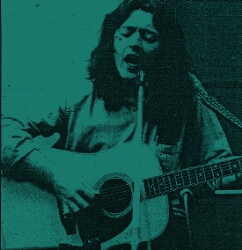 “Well,
I can't
remember exactly. I was doing odd bits of solos. I can't
remember how accurate it was. Between the ages of 12 and 14,
say, I was really struggling with it - in the sense that I`d come
from the acoustic guitar, which was very much rhythm stuff."
“Well,
I can't
remember exactly. I was doing odd bits of solos. I can't
remember how accurate it was. Between the ages of 12 and 14,
say, I was really struggling with it - in the sense that I`d come
from the acoustic guitar, which was very much rhythm stuff."
“Then I
started picking out the obvious Ventures and Shadows type
things, and Buddy Holly solos. I wasn't that concerned with
solos at the time, because there was no solid group, but by the time
I did join the showband, I knew the ‘Brown Eyed Handsome Man’
solo, and ‘Wishing’ and a couple of Chuck Berry solos.”
Gallagher
played
in the showband, Fontana, for two and a half years, and
went with them on tours of Ireland and even abroad while he was still
at school a trick managed, apparently, by changing
schools fairly often.
Eventually,
though, the showband repertoire of old time waltzes, Top 20 hits
and Clancy Brothers numbers began to pall slightly.
“I learnt
from
all these styles, but after a while I got well and truly cheesed off
with playing all this kind of stuff. I enjoyed the rock ‘n’ roll
numbers and some of the hit tunes we did, but I realized then that
the showband was OK for fairly constant gigs, and that was about
it.”
One of the
best
things to come out of this period was the Stratocaster that Gallagher
still uses as his main stage guitar.
“When I
joined
the showband, after a few months I got a Strat. It took me four
years to pay it off on HP. I`d borrowed a Hofner Colorama for a
while, which wasn't bad. Anyhow, I sold the Solid Seven when I got
the Fender, and borrowed a Vox AC30 from the bass player in the
band.”
What
follows is
a completely unsolicited testimonial for the manufacturers of the amp
mentioned, prompted only by an aside to the effect that
secondhand AC30's are still very expensive in the pages of
Exchange And Mart.
“They are
the
most reliable amp … really, very loud, and solid - although they do
need a little bit of something … like a treble booster, I
reckon."
“Somebody
worked it out once that they give closest to the true wattage; they
give 28 watts of real power, whereas some other makes only give 55
that are supposed to be one hundred watts."
“And they
have
a certain arrogant kind of tone, particularly if you get a nice
treble booster like a Rangemaster. You can get amazing sounds out of
them. Anyway, of course, The Shadows were using them, and that was
an instant encouragement, an endorsement.”
The amp in
question is now more or less of a first reserve, used occasionally
for recordings, but it gave good service through the showband
days and on into Taste, the three piece rock band Gallagher
formed afterwards.
Taste
started
out playing in Hamburg, masquerading somehow as a four piece,
and settled finally in London in 1969, going on to make a series
of albums as a heavy blues band. 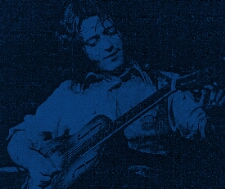
When they
split
he formed his own band, and the rest, says Gallagher, coming swiftly
and thankfully to the end of his dutifully compiled curriculum vitae,
I think is fairly well known.
By his own
account, Rory Gallagher can't read music. “I know what a certain
chord or chord change is, in music, just by putting two and two
together, so I'm not completely ignorant in that sense, and I could
probably play a couple of notes from a piece, but I would like to be
able to read music properly because it'd be very handy for
advancing one's knowledge.
“I have
made
serious attempts at it, and I do intend to learn but I just don't
seem to have had the time – it's a sad fact. I wish I could
learn.”
Well he
shouldn't get depressed - he hasn't done so badly …
“It's a
thing that happens to guitar players in particular. They move faster
than they can keep up with the technique. If it's rough and ready
music, of course … blues, rock or rhythm and blues … if those are
your main interests, or even if it's folk music and unusual types
of guitar styles, reading music doesn't seem to come into it so
much."
“I mean you
wouldn't equate Chuck Berry with reading music, or Leadbelly or
some of those greats.”
Point
taken, but
on the subject of direct influence from other musicians Gallagher is
slightly vague.
“In the
early
days it was Holly and Cochran, as I've said, and their solos were
tightly knit with chords and things, which I used to enjoy playing. For
the most part in the showband I was playing sort of
rhythm-cum-lead backings anyway."
“Now of
course, I've split them up much more. I'm not really aware that
anyone's influence has changed my style, because I dare to say that
I had a kind of a rough picture in mind all the time of what my style
was."
“Obviously
it's been tempered by different people through the years. You have
influences you don't even recognize as influences. Pete Townshend, for
instance, it never occurred to me he was an
influence, but it's true actually … those massive
chords."
“So far as
listening to other guitarists goes, I think, in all modesty, that my
style is strong enough to stand up to it, but, it's safer to listen
to lots of guitarists rather than to just one, it keeps
your ears wide open."
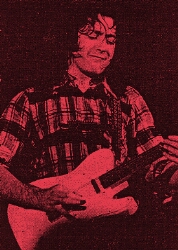 “Besides, I
think it's wrong when you hear players saying Johnny X is the king
of guitar players, and the rest of us are just servants, mere mortals
under his feet because there are so many good guitar
players, and so many different styles."
“Besides, I
think it's wrong when you hear players saying Johnny X is the king
of guitar players, and the rest of us are just servants, mere mortals
under his feet because there are so many good guitar
players, and so many different styles."
“In general
listening, I listen to The Beatles, The Byrds, The Band, Dylan …
you could go on and on. I'm not very narrow minded in
listening, though I might be narrow minded in what I play."
“Doc Watson
is
one of my favourites. For electric guitar I think John Hammond –
he's a guy from New York, a very primitive player, but very
good - Buddy Guy, J. B. Hutto, and Lowell George – he's a very
inventive slide player."
“Elmore
James
is fantastic, let it be said, though everyone's giving that the
thumbs down at the moment, but Lowell George is hitting some very
interesting notes more so than Ry Cooder or Duane Allman even."
“But then
Ry
Cooder’s more important in terms of resurrecting good songs. There
are so many good people around, you know. Martin Carthy is a
fine player. There are some guitarists who are primitive, but
who really lift me off the ground.”
It's
something
of a connoisseur's list, and Gallagher can bring the same
well informed discernment to bear on the subject of guitar
preferences.
“Well, I
like
the Stratocaster, and I still use the same one I had in the showband. I
think they penetrate best; you always hear them at the back of the
hall. I reckon that with the right amp a Strat is the best guitar,
because it has certain acoustic guitar like qualities. It has
the most natural sustain, for instance."
“It
wouldn't
have the electronic sustain of a Gibson or the big bottom of
some Gibson's, but it has a very direct hit – it's like a
dart."
“Telecasters
are nice, but they have one good pick up and the other isn't
quite so good and they have a slightly harder tone; the Strat has a
little more sophisticated sound. Great soul guitar or country
guitar, the Telecaster, if you want to get a good rocking sound."
“Then
there's
the Jazzmaster and the Jaguar, which didn't really do very well,
except in the surfing days. For Fender guitars you have to have
a good amp that gives a lot of sustain; Gibson's are more versatile,
you can plug them in anywhere, but for all their weighty sound they
don't have the same penetration."
“There are
really so many interesting guitars, and you can sometimes get a
really earthy, vicious sound from a rough old guitar that would be
impossible on a better one. I have an old Silvertone that cost me
£15, made out of plywood, but well disguised. I was given
a Guyatone in Japan, some sort of copy, and that has a honky
sound. I don't collect the glass case type of guitar, but I am a
guitar fan, I suppose, and I still like to go round the old music
stores and pawn shops just to see what there is.”
On stage
Gallagher uses three guitars: the Strat for standard work, a
Telecaster for slide, and either a National or a Martin for acoustic
playing. Amplification is courtesy of a Fender Bassman and a Fender
Twin, both mid 50s vintage, and used
turn and turn about
as the mood strikes. The AC30 waits in the wings.
“I don't
like big amps. I like built in amps, 30 to 50 watts, then you
know where the sound is coming from and the whole thing is right. These
old amps had standard speakers, you see - good old valves in
them - and the important thing was they were made by cabinetmakers,
and the wood was good.'
“Nowadays,
you
see speakers falling out of cabinets, the wood's so poor.”
Readers who
detect nostalgia for the good old days in Rory Gallagher's remarks
won't be surprised to learn that he doesn't hold with them
new fangled effects pedals.
“I don't
have anything against them, and I can admire players who use them,
but I've got this thing that, given I use a treble booster on stage
to give the amp more poke, otherwise I'm plugged more or less
straight in and I'm into what you can do with your hands within
that small range.”
And what
can you
do, Rory?
“You can do
miracles. I like the phase shifter sound – I've used that on
records, but the fuzz and the wah wah … I don't know … I
don't like to have to walk across the stage and press a button to
get a sound. I think you should have to create it with the
combination of the amp and the guitar, with your hands.”
Because of
his
insistence on natural sound, Gallagher has built up a vocabulary of
tonal effects achieved on the instrument, consisting largely of
tricks which were once widely used, but have now gone out of fashion.
For a
wah wah
effect he twirls the volume or tone controls.
“It's a
pretty old trick, but when I see a player doing it, it sounds twice
as effective as a wah wah pedal to me.”
For a
staccato
sound he damps the strings with palm of the right hand, just in front
of the bridge. Again it is an old rock ‘n’ roll technique, in
the tradition of Buddy Holly, “Wheels” and “Foot Tapper”
useful, incidentally, as a way of keeping the volume up while playing
softly.
A third,
and
more elusive, technique consists in coaxing harmonic runs from the
instrument by hitting strings with both the pick and the thumb
holding it, almost but not quite simultaneously. Once mastered, the
results are impressive.
While his
little
finger is busy twiddling knobs and shifting the pick up switch
(even, on the Strat) to an out of phase position between
two pick ups that apparently gives a distinctive tone), tome),
the rest of Gallagher's right hand is also fully occupied, since in
addition to holding a flat pick between thumb and forefinger, he uses
the remaining two fingers for acoustic style fill in picking.
Slide
guitar is
a major interest for Gallagher. On stage the ingredients are a
heavily strung Telecaster, an extensive knowledge of open
tunings, and a small American aspirin bottle, once used by Duane
Allman, placed over the third finger.
He also
uses a
conventional steel bottleneck, but the bottle was a particularly good
acquisition since it gives a smooth sound, is well made
with heavy glass … and once contained aspirin as well.
The subject
of
tunings for bottleneck style is a large one, but among those
Gallagher uses are, first, the standard guitar tuning in which Earl
Hooker played. This is not the easiest for slide guitar, and works
best in the keys of D and E.
Open
tunings
include A, E and D with an option on certain minor keys, and even a
curious system employed occasionally by Martin Carthy that involves
tuning three strings to one chord, three to another.
Slide
guitar has
its own techniques, like the rapid vibrato effect produced by
waggling the finger swiftly back and forth on the string, but the
main requirement in this kind of playing, where there is
absolutely no feel so far as position on the finger board is
concerned, is a very good ear … or better still, two.
These
Gallagher
possesses, and his playing, rooted in simple blues styles,
owes more to instinctive feel than to technique. 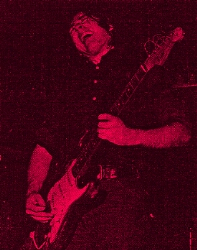
Asked to
have a
guitar handy for demonstration purposes, he was alarmed that he might
be expected to play set pieces, as he claims not to know any.
In fact,
the
best playing on the interview tape (shortly to be issued as a
bootleg!) comes while the interviewer is out of the room and the
microphone is unattended. After talking to himself briefly in an
impenetrable accent, Rory Gallagher settles down and produces a
short blues piece that is casually, but perfectly executed,
melancholy but startlingly clear, and evidently played straight off
the top of his head.
~~~~~~~~~~~~~~~~~~~~~~~~~~~~~~~~~~~~~~~~~~~~~~~~~~~~~~~~~~
From New Musical
Express November 9, 1974
Thanks to Brenda O'Brien for
sharing and typing this article!!
Article reformatted &
photos from the article mutated by roryfan
|
Mailing & Discussion List 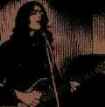 |
|
|
|
|
|
|
|
Forward
to next article |
250